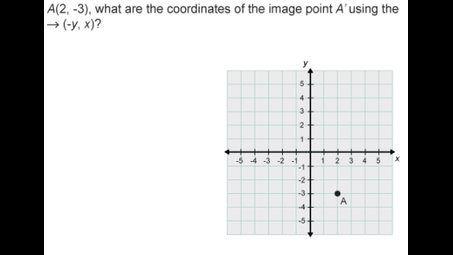What else can I help you with?
what- given a preimage point B (1, -3)?
4
what- given a preimage point A(-2, 1)?
2, -2
What are the three types of dilations in math?
The three types of dilations are an enlarged image (the image is larger than the preimage), a reduced image (the image is smaller than the preimage) and an equal image (the image is the same size as the preimage).
what- One triangle shown is the preimage and the other triangle is the image.If R is the name of a point in the preimage, fill in the blank with the name of the image.image?
R'
What does pre image mean in math?
In mathematics, a preimage refers to the original set of elements that map to a particular element or set under a given function. Specifically, if ( f: X \to Y ) is a function and ( y \in Y ), the preimage of ( y ) (denoted as ( f^{-1}(y) )) is the set of all ( x \in X ) such that ( f(x) = y ). In the context of sets, the preimage of a subset ( B \subseteq Y ) is the set of all elements in ( X ) that map to ( B ) under the function ( f ).
what- given a preimage point B (1, -3)?
4
Find the determinant of 1 a AA AA 1 a a AA 1?
Assuming that the terms, a and AA, are commutative, It is 1 + a^3 + (AA)^3 - 3aAA
suppose you are given a preimage and image?
perpendicular bisector
Given a preimage and image, which transformation appears to be a rotation?
answer
Given a preimage and image, which transformation appears to be a reflection?
answer
what- given a preimage point A(-2, 1)?
2, -2
Given a preimage and image, which transformation appears to be a translation?
up
Given the preimage of a quadrilateral and the translation vector shown at right, which of these diagrams shows the image constructed in the plane?
answer
A shape that results from a transformation of a figure known as the preimage?
Yeah, that's right it is called a preimage.
Identify the orientation where the image has same orientation as the preimage?
The answer is in the question! The orientation is the same as the preimage! Same = Not different.
Describe the difference between an image and a preimage?
A preimage is a transformed irritated or changed image. Such as a flipped triangle
what- Given a preimage point B(-2, 5) what are the coordinates B' if B is reflected in the x-axis?
(-2, -5)

